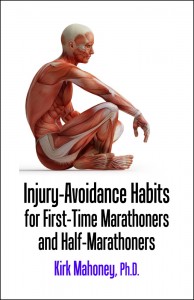Happiness and Predictability
 Happiness and predictability go together.
Happiness and predictability go together.
It feels odd to write that, given my belief that having low or no expectations and then being pleasantly surprised when things go well is a key to happiness.
But, beyond the joy of pleasant surprises, I believe that we need predictability, too, for happiness, especially for our happiness as runners and walkers.
Let me approach predictability from two angles to make my case.
One angle relates to a self-induced injury from a 14-mile run with my group-training program last weekend. The other angle relates to, well, relationships.
Predictability and Injury Avoidance
One of my favorite habits in my book Injury-Avoidance Habits for First-Time Marathoners and Half-Marathoners is the one that talks about protecting your skin from chafing. I recommend using an anti-chafing product such as Body Glide, but I recommend using kinesiology tape as an alternative to an anti-chafing cream or stick. The tape on the skin takes the brunt of any abrasive action from the fabric in your running apparel.
Starting a few years ago, I always ran with compression tights. I discovered soon after I started that the tights’ seam at the waist irritated my lower back. Ever since then, I would stick a 3-inch piece of kinesiology tape on my skin in that location.
Starting several weeks ago, I began running again with running shorts. I continued the tape approach, assuming that the shorts had the same issue of an abrasive seam.
I eventually realized that I could get by with an anti-chafing cream, so I began a few weeks ago to apply the cream instead of the tape prior to putting on my shorts for a long run.
As I recommend in the book, I put on my bathroom counter the anti-chafing cream the night before my 14-miler last Saturday morning.
I also put on the counter my deodorant, my sunscreen, and 1-inch pieces of kinesiology tape to protect my nipples.
[Tweet “The ‘see it so that you remember it’ approach to injury avoidance works well.”]
Cutting to the chase, I remembered to put the anti-chafing cream in some, er, more delicate areas but NOT along the waist line of my lower back. As a result, I ended up after the hot and humid 14-miler with what my wife says looked like the skin-irritation equivalent of a diaper rash, but in the shape of a horizontal stripe across my lower back. As I write this six days later, the area is still slightly scabby, but I decided to spare you from seeing the “medical photo” that my wife took soon after the 14-miler.
The lesson that I learned from this is that I got injured (nothing life-threatening, but still annoying) because I changed my routine without establishing a new habit. I intended that the anti-chafing cream be used for TWO purposes at 4:30 a.m. last Saturday morning (Yes, our group starts early on Saturdays.), whereas I’d built a habit for using it for only ONE purpose.
Rather than try to develop a new habit of using anti-chafing cream for a second purpose, I’m returning to my multi-year Friday-night habit of cutting a 3-inch piece of kinesiology tape and leaving it on my bathroom counter. In high-visibility bright pink (What can I say? I got a 50% discount by buying a giant roll directly from the manufacturer!), it’s obvious even in my semi-dazed state at 4:30 a.m. what to do with it on a Saturday morning.
Predictability and Relationships
Predictability in relationships may sound maddening or at least boring, but think about these pairs of statements related to your training, and then tell me which statements you prefer:
- “We never know when the coach will arrive.” vs. “The coach is always early.”
- “I never know whether he’ll be at the park.” vs. “I can count on him to join me for my run.”
- “I can’t predict whether she’ll leave me behind.” vs. “I can rely on her to stick with me even when I’m having trouble … or at least to make sure that I know my way back to the park before she takes off to finish the run.”
The first statement in each pair paints a picture of unhappiness. The second statement in each pair tells you about a happiness-inducing predictability in your relationships with other runners and walkers.
How Does Predictability Make You Happy?
How does predictability, especially as it relates to your running or walking life, make you happy? I’d like to know! Please leave a comment below.